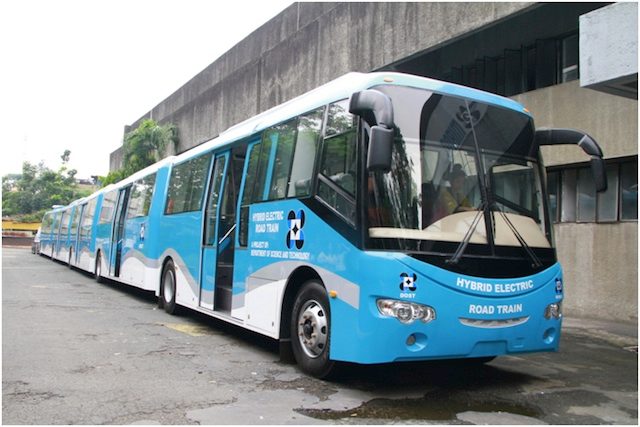SUMMARY
This is AI generated summarization, which may have errors. For context, always refer to the full article.

PAMPANGA, Philippines – It’s energy efficient, designed specifically for Philippine conditions, and it’s proudly locally made.
This is the hybrid electric road train, created by Filipino scientists and engineers at the Department of Science and Technology (DOST) as a response to the worsening mass transit problem in congested cities across the country.
Designed and produced by engineers from the DOST’s Metals Industry Research and Development Center, the 40-meter-long road train is eyed as a more efficient form of transportation. It can carry more passengers while producing less smoke emissions compared with cars, trucks, or buses.
“This road train is essentially multiplying the number of passengers who are utilizing limited road space,” DOST Secretary Mario Montejo said during the launch ceremony here on Thursday, June 25.
The vehicle is composed of 5 interlinked coaches, with 4 airconditioned cabins that can carry up to 60 passengers each – that’s a maximum of 240 passengers per trip. The rear coach carries the generator system.
It has a maximum speed of 50 km/h, and is powered by a hybrid engine that runs on either diesel fuel or electric batteries.
Adapted to PH conditions
Montejo said the road train, which took about P45 million to develop over 3 years, was a uniquely Filipino response to specific Philippine transport needs.
For instance, instead of using steel wheels, the vehicle uses rubber tires because it’s locally available and easier to replace. The interlinked coaches can also be modified depending on the roads where they will be deployed.
“The advantage is that we can design for our specific road conditions,” he said.
“Kayang tugunan ng sarili nating mga scientists at engineers ang sarili nating problema,” he added. (Our Filipino scientists and engineers are capable of solving our own problems.)
Asked if the vehicle is suitable for major roads like EDSA or C5, Montejo said: “Technically, it’s feasible.” Tests have already shown that the 5-coach train can navigate and turn at 3-lane roads.
It’s also been designed to work around a perennial problem in the metropolis: flooding.
With the engines elevated, the road train can still operate even with floods as high as 1.2 meters.
To make the ride experience appealing, DOST is eyeing a tap-and-go payment system to allow commuters to simply hop on for a trip.
Will frustrated Metro Manila commuters see the road train in action soon? Montejo said it will depend on business groups that may be interested in operating the units.
The hybrid electric road train is also set to be brought to Cebu for the transportation department’s bus rapid transit system, the DOST chief said.
“We hope to see them in our streets the moment they are fully commercialized,” he added. – Rappler.com
Add a comment
How does this make you feel?
There are no comments yet. Add your comment to start the conversation.